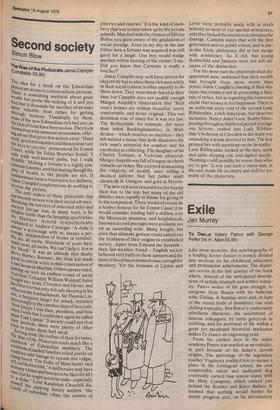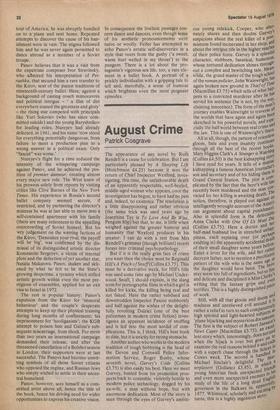Exile
Jan Murray
To Dan.* Valery Panov with George Feifer (W.H. Allen £6.95)
Like most memoirs, this autobiography of a leading Soviet dancer is loosely divided into sections on his childhood, education and professional achievements. The departure occurs in the last quarter of the book where, instead of the anticipated descriptions of artistic triumph and settled maturity, Panov writes of his grim struggle to emigrate from Russia with his ballerina wife, Galina. A familiar story and, in light of the recent trials of dissidents, one with chilling topicality. But Panov's exuberantly rebellious character, his assessment of famous colleagues, by turns generous or scathing, and his portrayal of life within a great yet moribund theatrical institution makes To Dance an engrossing read.
From his earliest days in the ballet academy Panov was marked as an outsider, part because of his father's Jewish origins. The patronage of the legendary teacher Vaganova enabled him to secure a place in the Leningrad school, his own irrepressible talent and dedicated slog eventually earned him soloist status with the Maly Company, which ranked just behind the Bolshoi and Kirov Ballets. It seemed that nothing would hinder his steady progress until, on his introductory
tour of America, he was abruptly bundled on to a plane and sent home. Repeated attempts to discover the cause of his banishment were in vain. The stigma followed him and he was never again permitted to dance abroad as a member of a Soviet troupe.
Panov believes that it was a visit from the expatriate composer Ivor Stravinsky, who admired his interpretation of Petrushka, that secured him a rare transfer to the Kirov, seat of the purest traditions of nineteenth-century ballet. Here, against a background of casting couch manoeuvres
and political intrigue — a film of dirt everywhere coated the greatness and glory' — the rising star competed with principals like Yuri Soloviev (who has since committed suicide) and the young Baryshnikov for leading roles. Nureyev had already defected, in 1961, and his name 'now stood for everything potentially dangerous, from failure to meet a production plan to a wrong answer in a political exam. Only "fascist" was worse.'
Nureyev's flight for a time reduced the intensity of the whispering campaign against Panov, and he achieved the position of premier danseur, creating almost every major new role. The West knew of his prowess solely from reports by visiting critics like Clive Barnes of the New York Times. His experience in Russia's second ballet company seemed secure, if restricted, and by partnering the director's mistress he was at last able to move into a self-contained apartment with his family (there are many references to the appalling overcrowding of Soviet homes). But his wry judgement on the warring factions of the Kirov, 'Denounce your rival, the payoff will be big', was confirmed by the dismissal of its distinguished artistic director Konstantin Sergeyev, a victim of internal plots and the defection of yet another star, Natalia Makarova. Panov, shaken and sickened by what he felt to be the State's growing despotism, a tyranny which stifled artistic growth within even the most prestigious of ensembles, applied for an exit visa to Israel in 1972.
The rest is popular history: Panov's expulsion from the Kirov for 'immoral behaviour' and the couple's desperate attempts to keep up their physical training during long months of confinement; his imprisonment for 'hooliganism'; the KGB attempt to poison him and Galina's subsequent miscarriage, from shock. For more than two years an international campaign demanded their release, and after the threatened cancellation of a Bolshoi season in London, their supporters were at last successful. The Panovs had become unwitting symbols of all those Soviet citizens who opposed the regime, and Russian Jews who simply wished to settle in their ancestral homeland.
Panov, however, sees himself as a committed artist above all, hence the title of the book, hence his driving need for wider opportunities to express his creative vision. In consequence the liveliest passages concern dance and dancers, even though some of his aesthetic pronouncements were naive or woolly. Feifer has attempted to echo Panov's erratic self-discoveries in a style that veers from the gushy Ca sweet, warm hurt welled in my throat') to the pungent. There is a lot about the protagonist's vigorous sex life, too, a rare element in a ballet book. A portrait of a prickly individualist with a gripping tale to tell and, mercifully, a sense of humour which brightens even the most poignant episodes.



































 Previous page
Previous page